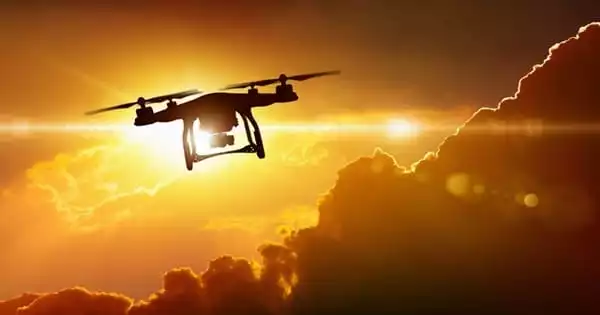Hoverfly visual systems have been reverse engineered to detect drone audio fingerprints from nearly four kilometers away, according to researchers. The discovery could aid in the fight against the increasing use of IED-carrying drones, such as those deployed in Ukraine.
Australian researchers reverse-engineered the visual system of hoverflies, a nectar-feeding insect, to identify the auditory signature of drones from up to four kilometers (about 2.5 miles) away, even in loud situations. For the first time, Australian scientists reverse-engineered hoverfly visual systems to identify drone audio fingerprints from nearly four kilometers away.
Experts in autonomous systems from the University of South Australia, Flinders University, and the defense business Midspar Systems claim that testing utilizing bio-inspired signal processing techniques indicate up to a 50% greater detection rate than previous methods. The findings, which could aid in combating the expanding global threat presented by IED-carrying drones, were published in The Journal of the Acoustical Society of America.
According to Anthony Finn, a UniSA Professor of Autonomous Systems, insect vision systems have been mapped for some years now to improve camera-based detections, but this is the first time that bio-vision has been applied to sound data.
The impact of UAVs in modern warfare is also becoming evident during the war in Ukraine, so keeping on top of their location is actually in the national interest. Our research aims to extend the detection range considerably as the use of drones increases in the civilian and military space.
Professor Anthony Finn
“Bio-vision processing has been demonstrated to significantly improve drone detection range in both optical and infrared data. However, we have now demonstrated that using an algorithm based on the hoverfly’s visual system, we can detect distinct and crisp audio signatures of drones, including very small and quiet ones,” Prof Finn explains.
The excellent vision and tracking abilities of the hoverfly have been successfully modelled to identify drones in busy, complex, and cryptic surroundings, for both civilian and military reasons.
“Unauthorized drones pose unique hazards to airports, people, and military locations.” As a result, it is becoming increasingly important for us to be able to detect particular positions of drones across vast distances utilizing systems that can pick up even the weakest signals. Our trials using the hoverfly-based algorithms show we can now do this,” Prof Finn says.
Dr. Russell Brinkworth, Associate Professor in Autonomous Systems at Flinders University, believes that the ability to see and hear small drones from a greater distance could be extremely useful for aviation regulators, safety authorities, and the general public seeking to monitor an increasing number of autonomous aircraft in sensitive airspace.
“In recent years, we’ve seen drones enter areas where commercial airlines land and take off, so gaining the capability to actually monitor tiny drones when they’re operating near our airports or in our skies may be highly valuable to enhancing safety.”

“The impact of UAVs in modern warfare is also becoming evident during the war in Ukraine, so keeping on top of their location is actually in the national interest. Our research aims to extend the detection range considerably as the use of drones increases in the civilian and military space.”
Bio-inspired processing boosted detection ranges by 30 to 49% when compared to standard techniques, depending on the type of drone and the conditions.
Researchers look for specific patterns (narrowband) and/or generic signals (broadband) to detect drone acoustics at short to medium distances, however the signal weakens at greater distances, and both strategies struggle to generate consistent results. Similar situations can be seen in nature. Researchers explain that while dark light areas are incredibly noisy, insects like the hoverfly have a very sophisticated visual system that can collect visual signals.
“We worked under the notion that the same procedures that allow small visual targets to be spotted amongst visual clutter might be redeployed to recover low volume audio signals from drones buried in noise,” Dr. Brinkworth explains.
“We’ve seen drones enter areas where commercial airlines land and take off in recent years, so creating the capacity to actually monitor tiny drones when they’re operating near our airports or in our skies may be extremely advantageous towards enhancing safety,” he adds.
According to the researchers, the findings could aid in combating the expanding global threat presented by IED-carrying drones, including the ongoing conflict in Ukraine. Researchers employed the neurological circuitry of the hoverfly brain to improve and suppress unrelated signals and noise, extending the detection range for the sounds they wished to detect by transforming auditory data into two-dimensional ‘pictures’ (called spectrograms).
The financing partially supports technology solutions to address the weaponization of drones, which are currently among the most lethal weapons in modern warfare, killing or injuring over 3000 enemy soldiers in Afghanistan and are being used in the current conflict in Ukraine.
















